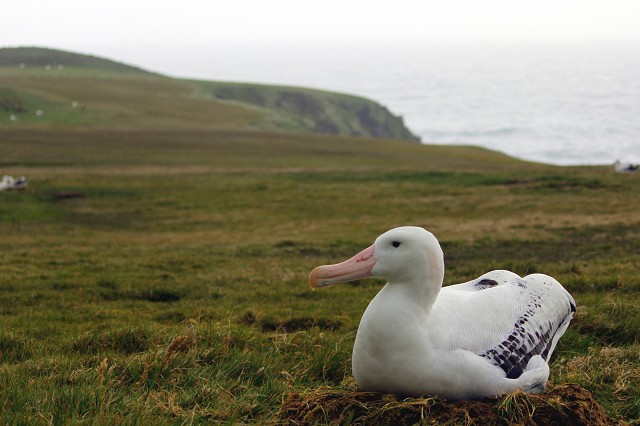A new study has suggested that the body condition of male Wandering Albatrosses will play a big part in the species' continued survival.
One of the predicted consequences of climate change is a shift in body mass distributions within animal populations. Yet body mass, an important component of the physiological state of an organism, can affect key life-history traits such as survival, chick mass and breeding success and population dynamics. It is widely expected that variation in body mass distribution will have consequences for the conservation of particular species.
Researchers from Swansea University, along with partners in Switzerland, France and the USA, have examined the body mass of Wandering Albatross, a monogamous and sexually dimorphic species (males are considerably heavier than females) which shares parental care. In recent decades, the species has exhibited an increase in average body mass and breeding success in parallel to experiencing increasing wind speeds across its range.
The study concluded that there was a clear difference between Wandering Albatross sexes. Increased male body mass enhanced performance in adult survival, breeding success, chick mass and juvenile survival, whereas this was not the case for females. Adult males also had heavier sons but not heavier daughters. This suggests that a higher investment by fathers in their sons but not in their daughters can increase their overall fitness.
While the recent observed upturn in breeding success and survival rates is positive news for Wandering Albatrosses, uncertainty remains how future climatic change may impact body mass and, consequently, various life-history traits which ensure the species' life cycle continues to be sustainable.

Male Wandering Albatross on its nest (Photo: Swansea University).
Speaking about the research, which has just been published in Proceedings of the Royal Society B, Luca Börger, Professor of Ecology and Biodiversity, explained: "Our results showed that among long-lived species, a relationship between body mass and survival can be present independently of environmental conditions. The survival of one sex can be affected by body mass but not the other, probably due to sex-specific energy requirements. Furthermore, we showed that life-history traits related to reproduction of species with sexual size dimorphism and bi-parental care can vary exclusively with body condition of the sex contributing the most to reproduction.
"How can this happen? Theory on resolution of parental conflict over care provides a framework to explain how such a pattern may emerge: when, for the same cost to the parents, the benefits derived by the offspring produced from the care of each parent are unequal, then the parents contributing less in absolute terms (the lighter females) may not be able to compensate.
"Our results also have wider implications, which we are addressing in further research. When some life-history traits are mass-dependent, variation in mass distribution is expected to have consequences at population level. Given that body mass has been reported to have changed over the past years with wind speed in both sexes, understanding how a climate-driven change in this trait will affect population dynamics will prove crucial for the conservation of this species."
Reference
Cornioley T, Jenouvrier S, Börger L, Weimerskirch H & Ozgul A. 2017. Fathers matter: male body mass affects life-history traits in a size-dimorphic seabird. Proceedings of the Royal Society B, vol 284, issue 1854. DOI: https://doi.org/10.1098/rspb.2017.0397


